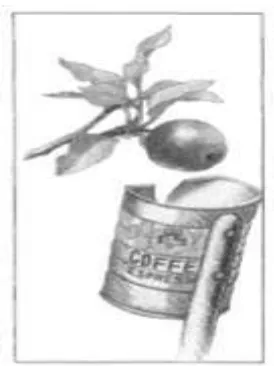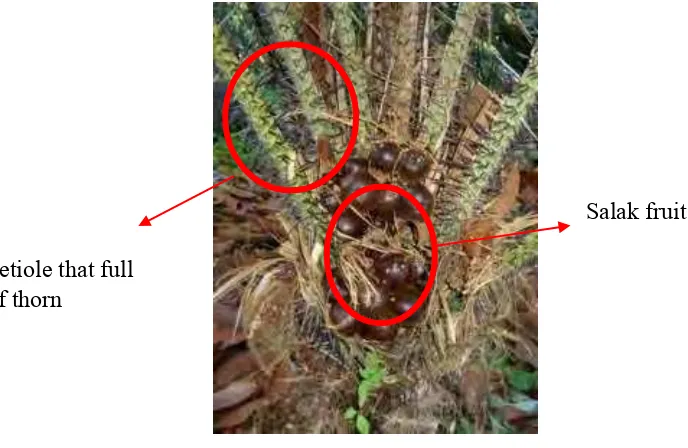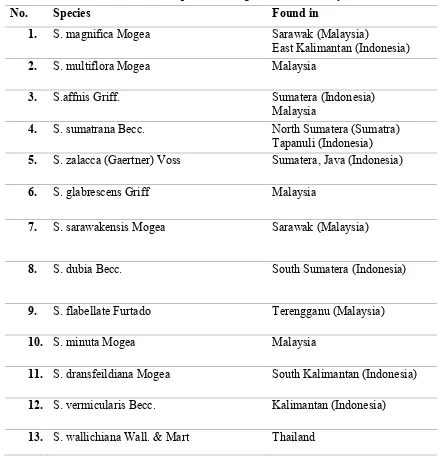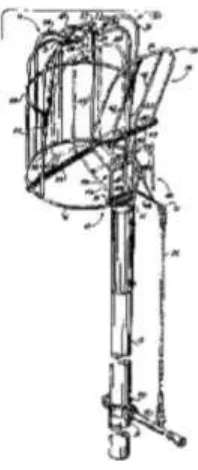ii
SUPERVISOR DECLARATION
“I hereby declare that I have read this thesis and in my opinion this report is sufficient in terms of scope and quality for the award of the degree of Bachelor
of Mechanical Engineering (Design and Innovation)..
iii
DECLARATION
“I hereby to declare that this project report entitle DESIGN AND FABRICATE THE MODEL OF AN INNOVATIVE PLUCKING DEVICE FOR SALAK FRUIT is written by me and is my own effort except the ideas
and summaries which I have clarified their sources “.
Signature :……….
iv
To my lovely parents, Mr. Majid b. Embong and Mdm. Zaipah bt. Salleh. For everlasting support, Mohd. Syazwan b. Ismail, friends, Nur Syafiqah bt. Ismuini, Fong Shon Feng, Nur Aizatul Ain bt. Md. Zahir, Nor Ana bt. Rosli, Nur Farah Izyan, Dayangku Khadijah. Lecturer, Dr. Mohd. Asri b. yusuff for
v
ACKNOWLEDGEMENT
Greatest praise to Allah Almighty. Grateful to Him with His will I had successfully finished in preparing this ‘Projek Sarjana Muda’ thesis.
Several people played an important role in the accomplishing of this ‘Project Sarjana Muda’ thesis and I would like to acknowledge them here.
I owe my most sincere gratitude to Mr. Mohd Asri b Yusuff. I would like to thank him for his guidance, support, advices and time during the course of my project Special thanks to FKM technicians whom are patient in giving me a lot of advice and useful tips in performing the research.
vi
ABSTRACT
vii
ABSTRAK
Tujua uta a projek i i adalah u tuk ereka ipta Pe etik Buah “alak ya g i ovatif u tuk ersai g de ga pihak lai di pasara . Projek i i
terutamanya berfokus pada proses mereka cipta pengait buah salak yang mempunyai kriteria rekebentuk yang baik seperti ergonomik, mudah untuk difabrikasikan, mempunyai nilai estetik, harga terendah dan lain-lain. Penyediaan pemetik buah peranti mekanik, sebagaimana disebutkan di atas, adalah bersaiz kecil dan cukup sederhana untuk dikendalikan secara manual oleh buruh tani biasa yang terdiri daripada golongan lelaki, perempuan atau anak-anak. Sebelumnya usaha telah dilakukan untuk menyediakan peralatan pemetik buah. Malangnya, tiada pemetik buah yang sesuai untuk digunkan bagi memetik buah salak kerana galah yang direka biasanya mempunyai batang yang panjang dan penyakutnya tidak terlalu kuat untuk memotong tandan salak. Biasanya, petani hanya menggunakan pisau atau sabit untuk buah ini tetapi cara ini tidak terlalu sesuai. Pemetik buah salak yang efisyen akan direkabentuk dan mengikut keperluan pengguna dimana akan memudahkan kerja-kerja memetik tanpa sakit terkena duri salak.
viii
CONTENT
CHAPTER TITLE PAGES
SUPERVISOR DECLARATION DECLARATION
DEDICATION
AKNOWLEDGEMENT ABSTRACT
ABSTRAK CONTENT
LIST OF TABLES LIST OF FIGURES LIST OF APPENDIX
ii iii iv v vi vii viii xii xiii xvi
CHAPTER Ι INTRODUCTION
1.1 Background 1.2 Problem Statement 1.3 Objective
1.4 Scope
1.5 Report Frames
ix
CHAPTER ΙΙ
CHAPTER ΙΙΙ
LITERATURE REVIEW 2.1 INTRODUCTION
2.2 DESCRIPTION OF SALAK FRUIT 2.3 RESEARCHED PATENT
2.3.1 Hand-operated Fruit Picker 2.3.2 Combined Tree Saw, Pruner,
And Paint Spray
2.3.3 Hand-Operated Fruit Picker 2.3.4 Fruit Picker
2.3.5 Coconut Plucker. 2.3.6 Sickle
2.4 MATERIAL USED 2.5 DESIGN CRITERIA 2.5.1 Requirement
2.5.2 Safety and Ergonomic 2.6 METHOD TO COLLECT
INFORMATION
METHODOLOGY
3.1 INTRODUCTION 3.2 IDENTIFYING CUSTOMER
NEEDS
3.2.1 Method to Gather Information From Customer 3.3 PRODUCT DESIGN
SPECIFICATION
3.4 CONCEPT GENERATION 3.5 CONCEPT SELECTION
x
3.5.1 Ergonomic Needs 3.6 DESIGN TOOL
3.6.1 Fundamental and Basic Principle of CAD
3.7 DESIGN ANALYSIS TOOL 3.7.1 CATIA Structural Analysis 3.7.2 Finite Element Analysis
34 35 36 37 37 37
CHAPTER ΙV RESULT AND DISCUSSION
4.1 INTRODUCTION 4.2 CUSTOMER NEEDS
4.2.1 Questionnaire Analysis 4.3 PRODUCT DESIGN
SPECIFICATION
4.3.1 Engineering Characteristic 4.3.2 Customer Requirement 4.4 MORPHOLOGICAL CHART 4.5 CONCEPTUAL DESIGN 4.5.1 Concept Design 1 4.5.2 concept design 2 4.5.3 concept design 3 4.6 CONCEPT EVALUATION 4.6.1 Best Concept Design 4.7 MATERIAL SELECTION 4.7.1 Housing
4.7.2 Blade And Rod Blade 4.7.3 Lever
4.7.4 Strap 4.7.5 Handle
4.8 STRUCTURE MODELLING 4.8.1 Product Structure Tree
xi
4.9 CALCULATION 4.10 DESIGN ANALYSIS 4.11 MANUFACTURING COST 4.11.1 Value Analysis In Costing
4.12 MANUFACTURING PROCESS FLOW
69 71 72 72 76
CHAPTER V CONCLUSION AND
RECOMMENDATION 5.0 CONCLUSION
5.2 RECOMMENDATION REFERENCE
APPENDIX
xii
LIST OF TABLES
NO. 2.1 2.2 3.1 4.1 4.2 4.3 4.4 4.5 4.6 4.7 4.8 4.9 TITLE
South-East Asian species of the genus Salacca The basic ingredient of steel and their uses. A sample of morphological Charts.
House Of Quality
Description for every criteria in engineering characteristic.
Description for every criteria in customer requirement. The Idea Generated Part By Part.
Concept Evaluation
Cost Structure For A Salak Fruit Plucker
Function Provided By Each Component For The Salak Fruit Plucker
Cost Structure For Salak Fruit Plucker With Function Cost Allocation
Calculation Of Function Costs For Salak Fruit Plucker
xiii
LIST OF FIGURES
NO. 2.1 2.2 2.3 2.4 2.5 2.6 2.7 2.8 2.9 2.10a 2.10b 2.11 3.1 3.2 4.1 4.2 4.3 4.4 4.5 4.6 TITLE
Example Of “Shearing “Mechanism. Example Of “Pulling” Mechanism. Salak Tree
Hand –operated Fruit Picker
Combined Tree Saw, Pruner, And Paint Sprayer Hand-Operated Fruit Picker
Fruit Picker Coconut Plucker. Sickle
Type of Direction Of Force Tables Of Force
The measurement of (a) man and (b) woman. Project Flowchart
House of Quality
The Graph Of The Salak Plucker Usage
The graph of percentage people did ever used the fruit plucker
The graph of mechanism to pluck the fruit.
The graph of whether having a problem or not by using mechanism stated above.
The graph of problem face during retrieving the fruit. The graph of important factor in salak fruit plucker.
xiv 4.7 4.8 4.9 4.10 4.11 4.12 4,13 4.14a 4.14b 4.14c 4.14d 4.15a 4.15b 4.16a 4.16b 4.17 4.18 4.19 4.20 4.21 4.22 4.23 4.24 4.25 4.26
The graph of the way user prefer to cut the stem.
The graph of percentage of user that willing to pay more Range of price that the customer willing to pay.
Concept Design 1 Concept design 2 Concept design 3
The Best Design Concept. Case Hook Wicket Lid Rod Blade Arm connector Arm bar Strap Handle
3D Rough Modelling
3D Rough Modelling Exploded View The Product In An Original Mode The Product In Cutting Mode Free-body Diagram Of The Plucker The graphical method of calculation. CATIA Structural Analysis on Blade CATIA Structural Analysis on Handle
xv
LIST OF APPENDIX
NO.
A
B
TITLE
Gantt Chart PSM Ι Gantt Chart PSM Ι Questionnaire
Exploded View Drawing Orthographic View Drawing
PAGE
1
CHAPTER Ι
INTRODUCTION
1.1 BACKGROUND
2
1.2. PROBLEM STATEMENT
The salak is a species that native to Indonesia but now is grown and produced around Southeast Asia including Malaysia and Thailand. Although the salak tree is really short, growing on the ground, the fruit surrounds by the needle-like, sharp thorns on the petiole give difficulties to the people to pick the fruit. Normally, the people will use knife to dig the fruit up from the bunch to avoid the fingers from injured by the thorn. This unfortunately will cause the unripe fruit also fall down from the bunch as the fruit is so close to one another. Besides, the use of knife does not give a full protection to the hand from injured by the thorn unless the thick rubber gloves is worn.
There are a lot of fruit plucker that has been invented. However, such plucking equipment are mostly for plucking the fruits up on the tall trees. For example, the pluckers are normally have a long pole yet so heavy to be handle. The mechanism of the plucker also complicated and just suitable to hook the fruit down to the ground.
1.3. OBJECTIVE
In this project, a few objective must be achieve in order to ensure that the salak’s plucker device can function perfectly according to its purpose of designed. Basically, the objective of this project are:
a) To design and fabricate the model of the suitable device to pick the salak fruit safely.
3
1.4. SCOPE OF PROJECT
This project is narrowed down to certain scopes which has been identified based on the project objectives. The scope that been emphases is to develop a salak fruit plucking device within the criteria such as ergonomic, easy to fabricate and with aesthetic value. This add on value is important as an attraction to the customer.
Besides, the provision of mechanical fruit plucking device is small in size and simple enough to be held and manually operated by the usual farm laborer whether such laborer be a man, woman or child should also be emphasize. The design should be focus on how to reduce the weight of the plucker and also study on how to reduce the force consume by the user with the strong output force.
Other than that, the scope includes to design and analysis using engineering software, CATIA V5R19 and CATIA structural analysis. Therefore, the software should be studied to analyses the design of the plucker before it is being manufactured.
1.5. REPORT FRAMES
This project entitled “Design and Fabricate the Model of an Innovative Plucking Device for Salak Fruit to Be Commercialized” can be divided into five chapters. Chapter 1 which is the introduction explains the general information of the fruit plucker. The element that consist in chapter 1 are background of fruit plucker, problem statement of the project, scope of projects, objectives of project and report organization.
4
chapter is discussing the method used throughout the development of salak plucker. It started with the section identifying customer needs using interview method. Concept selection method and software use to generate the design also had been explained in this chapter. The steps involve in the process of develop the salak plucker are described in detail in this chapter.
5
CHAPTER ΙΙ
LITERATURE REVIEW
2.0 INTRODUCTION
6
[image:20.612.269.406.346.529.2]Figure 2.2 Example of “pulling” mechanism (Source: Hernandez et.al, 2000) Figure 2.1 Example of “shearing “mechanism.
7
2.2 DESCRIPTION OF SALAK FRUIT
Salak fruit is a short-stemmed palm with big leaves up to 6m length, petiole up to 2m long with back up to 15cm long. The fruit always grow in branches at the base of the palm. It is also known as the snake fruit due to reddish-brown and scaly skin. They are about the size and shape of a ripe with a separate tip. The fruit inside consists of 3 lobes, each with large inedible seed. The lobes resemble, and have the consistency of large peeled garlic cloves (Christian, 2012).
The Salak is a species that native to Indonesia but is now grown and produced around Southeast Asia including Malaysia and Thailand. The taste is usually sweet and slightly acidic, but its apple-like texture can be varying from very dry and crumbly to moist and crunchy (Christian, 2012). Its tasty taste make people craving for this fruit but unfortunately the palm is full of thorn. In Malaysia, the seed is brought from the Indonesia and start to farm widely. Then, cottage industry begin to produce salak pickle which is very popular in countryside.
8
[image:22.612.176.520.59.283.2]Based on Mogea (1986-1990), about nineteen species of Salacca has been identified. They are found over southern Yunnan, lower Burma, Thailand, the Malay Peninsula, Sumatera, West-Java, Borneo (Kalimantan) and the southern part of the Philippines. The largest number of species is found in Borneo, about ten species. In the Malay Peninsula and Sumatera, seven species each are found. Out of nineteen species, thirteen have been identified in South-East Asia (see Table 2.1). Of the species listed in Table 2.1, S. sumatrana, S. zalacca and S. wallichiana are cultivated the first two mainly in Indonesia (Mogea, 1986; Schuiling and Mogea, 1991), the latter almost exclusively in Thailand (Polprasid, 1991). The most distinct character of this group is that the species are dioecious (reproductive way) and need pollinator plants to produce fruits.
Figure 2.3 Salak Tree
(International Tropical Fruit Network, 2011)
Salak fruit Petiole that full
9
Table 2.1 South-East Asian species of the genus Salacca (Haryani, 1994).
*Scientific names according to Ferguson (1986) and Mogea (1986).
No. Species Found in
1. S. magnifica Mogea Sarawak (Malaysia)
East Kalimantan (Indonesia) 2. S. multiflora Mogea Malaysia
3. S.affnis Griff. Sumatera (Indonesia) Malaysia
4. S. sumatrana Becc. North Sumatera (Sumatra) Tapanuli (Indonesia) 5. S. zalacca (Gaertner) Voss Sumatera, Java (Indonesia) 6. S. glabrescens Griff Malaysia
7. S. sarawakensis Mogea Sarawak (Malaysia)
8. S. dubia Becc. South Sumatera (Indonesia)
9. S. flabellate Furtado Terengganu (Malaysia) 10. S. minuta Mogea Malaysia
10
2.3 RESEARCHED PATENTS
2.3.1 Hand-operated Fruit Picker
[image:24.612.256.355.408.643.2]This fruit picker consists of a pole and a fruit-receiving cage. This cage is an adjustable, outwardly concave scoop. It has a gap that helps capturing and gathering the picked fruit. The interior of the cage is a cushioned lining that provides protection to the perishable ripe fruit. This design helps to develop ideas about fruit gathering. It is more efficient to pick the fruit down the tree into the basket instead of gathering one by one in the ground. However, this particular fruit picker has two disadvantages. First, the fruit has to be pulled from the branch, leaving the great potential for fruit damage. Second, by gathering fruits in the cage at the end of the pole, large moment will be produced causing operator fatigue. From this patent, it give the picture on how the mechanism of the plucker should operate although the cage mechanism does not quite suitable for the salak fruit.



